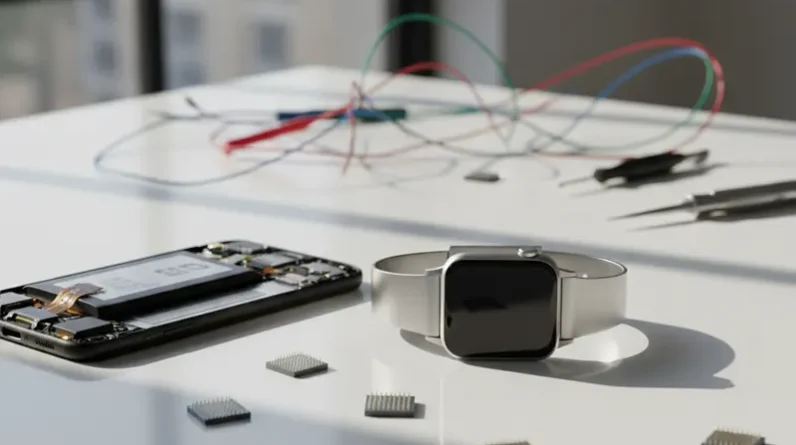
We’ve seen smart device features evolve dramatically from the basic touchscreens of the 1980s to today’s AI-driven innovations. Early resistive touchscreens gave way to capacitive ones, enhancing interfaces. Connectivity and multimedia advanced with Wi-Fi and high-resolution displays. Personalization and security grew through biometrics and encryption. Now, AI and automation anticipate our needs. There’s so much more to uncover about how these technologies continue to shape our interactions with smart devices.
Early Innovations in Smart Device Features
As we explore the early innovations in smart device features, it’s clear that the foundation of today’s technology was built on pioneering ideas that emerged in the late 20th and early 21st centuries. We can trace the inception of touchscreens to the 1980s, when resistive technology enabled basic stylus interactions on early PDAs. By the early 2000s, capacitive touchscreens revolutionized user interfaces, offering intuitive finger-based control.
We also recognize the significance of early software ecosystems. Platforms like Symbian and Windows Mobile introduced rudimentary app stores, setting precedents for customizable user experiences. These breakthroughs in hardware and software design laid critical groundwork, shaping how we interact with devices and heralding a new era of personal technology.
The Rise of Connectivity and Multimedia
While early innovations in smart devices focused on usability and basic functionality, we soon witnessed a transformative shift with the rise of connectivity and multimedia capabilities. We’ve seen devices evolve from isolated tools to interconnected hubs, integrating Wi-Fi and cellular networks for seamless internet access. This connectivity enables real-time communication and data sharing, fundamentally changing how we interact with technology.
Multimedia advancements, too, have redefined user expectations. High-resolution displays, powerful cameras, and enhanced audio systems now deliver immersive experiences, turning devices into portable entertainment centers. We’re observing how these features drive demand for faster processors and larger storage to support streaming and content creation. Together, connectivity and multimedia have elevated smart devices into essential, multifaceted tools for our digital lives.
Shift Toward Personalization and Security
Beyond the advancements in connectivity and multimedia, we’re seeing a significant shift toward personalization and security in smart devices. As users demand more tailored experiences, manufacturers prioritize features that adapt to individual preferences while safeguarding data. We’re observing how this dual focus reshapes device design and functionality to meet sophisticated user expectations.
To understand this trend, consider these critical developments:
- Customizable Interfaces – We’re witnessing devices offering adaptive layouts and settings, ensuring a unique user experience.
- Biometric Authentication – Technologies like fingerprint and facial recognition are becoming standard, enhancing security.
- Encrypted Data Protocols – We’re noting stronger encryption methods to protect personal information from breaches.
Together, these innovations reflect our growing need for control and protection in an interconnected world.
Emergence of Artificial Intelligence and Automation
Now that we’ve explored personalization and security, let’s turn our attention to the emergence of artificial intelligence and automation in smart devices. We’re witnessing a transformative shift as AI integrates into everyday technology, enabling devices to learn from user behavior and anticipate needs. Automation streamlines repetitive tasks, from scheduling to home management, enhancing efficiency.
Smart assistants, powered by sophisticated algorithms, process natural language to execute complex commands with precision. We can’t ignore how machine learning refines decision-making, adapting to patterns over time. This synergy of AI and automation reduces manual intervention, offering seamless interaction. As we analyze this evolution, it’s clear that these technologies redefine convenience, pushing smart devices beyond mere tools into proactive companions for our daily lives.
Future Trends in Smart Device Capabilities
How will smart devices evolve in the coming years to meet our ever-changing demands? We’re witnessing a pivot towards more intuitive, adaptive technologies that anticipate needs with minimal input. As we analyze emerging trends, it’s clear that innovation will focus on seamless integration and enhanced user empowerment.
Let’s dissect the key trajectories shaping this landscape:
- Advanced Contextual Awareness – Devices will leverage sophisticated sensors and AI to predict user behavior, adapting interfaces dynamically.
- Sustainable Design Integration – We’ll see energy-efficient systems and eco-friendly materials dominate, aligning with global sustainability goals.
- Enhanced Privacy Frameworks – Expect robust, user-controlled data protection mechanisms as privacy becomes paramount.
We anticipate these advancements will redefine interaction, pushing smart devices beyond mere tools into true extensions of ourselves.
Conclusion
As we peer into the future of smart devices, we’re thrilled to witness a world where innovation never sleeps. These gadgets aren’t just tools; they’re our trusted companions, evolving to anticipate our every need with a wink of artificial intelligence and a nod to tighter security. Let’s embrace this exciting dance of technology, where each step forward promises to make our digital lives smoother and ever more enchanting.







